
 |
|
||||||||
4. Concepts of the comparable sales approach in commercial vessel evaluation
In the process of value determination (or other economic index) of vessel or other real asset of the marine company’s property complex based on comparable sales approach there is a simple and rather affordable way to the apply the statistical regressions on the basis of similarity with analogues at the level of specific indexes as the alternative to searching of analogues and introducing of adjustments for the analogues’ values.
4.1. Comparability characteristics and units
The comparison signs (that is, a similarity with analogues) should be taken into account while creating of statistical regressions according to analogues.
Evaluation based on comparable sales approach is based on marketing researches and on the account of following general factors – characteristic of the comparison:
– Transaction conditions, that are mainly the structure of the transferred rights and the time of sale for analogues and for an evaluated vessel; the age is used, and the transferred rights are defined according to Article 209 of the Civil code of the Russian Federation;
– Macroeconomic restrictions and market conditions, i.e. the situation which have developed in the market; in particular, considered by the statistical researches when formalizing of the regressions;
– Technological (microeconomic) conditions that are the functional or structural characteristics of similarity with analogues; the corresponding units of comparison are used, which are, on the other hand, the identification signs of a commercial vessel (see Chapter 3) or another asset of the marine company.
Concerning the features of the application of the comparable sales application for an evaluation of the marine commercial vessels, some explanation is required.
Definition of valid data of the commercial vessels–analogues is one of the key questions when using the comparable sales approach.
Apparently, the applied data about the analogues’ values demand mutual check that is correlation of data – the specific indexes determined from the various sources for the objects of the same class.
For the reliability criterion for this reason, can possibly satisfy the statistical population of market data in the whole, instead of each of analogues as a part of this population, taken separately.
The requirements for reliability of the used data of vessels–analogues’ reliability and the necessity for this reason of statistical sets extensive enough lead to expediency of the similarity analysis at the level of specific indexes with the account the distinctions of units of comparison values for the majority of vessels–analogues and for an evaluated vessel.
As effective option of the comparable sales approach application for the vessel evaluation can serve the regression analysis, in the frameworks of which the similarity of analogues and an evaluated vessel is reached at the level of specific indexes.
While using of the statistical sets of commercial vessels–analogues’ values, that for example, have similar purpose of use not only the analogues coinciding with the evaluated vessel by the units of comparison are of informational importance, but also the other vessels of a used set since all the applied statistical set defines the regression characteristics, that is, the regression dependence of the vessel value on a unit of comparison can be restored to some extent of proximity on the basis of data not only (and not much) of the analogues which have coincided with the evaluated vessel in a narrow interval of the values of comparison units, that is the eventuality, but of any analogues from the used set. Therefore it is inexpedient to reduce the used statistical set in view of commercial vessel evaluation objectivity the comparable sales approach.
In an opposite option, in case of reduction of the used statistical set to the analogues which have occasionally coincided with the evaluated vessel by the units of comparison value, there is an illusion of evaluation accuracy increase, that actually testifies the loss of part of the information about the value and the loss of objectivity of the evaluation by the comparable sales approach.
The reliability of data about value of analogues is characterized by objectivity (authenticity) of data and accuracy. A dominating condition, apparently, is authenticity.
In case of accumulation of the statistical information on vessels values, to put it more exactly, about the specific values related to the units of comparison, the following circumstance appears: the authenticity of data is promoted by the increase of data quantity, the significant spread of values is thus characteristic.
Due to the specified reasons the objective data about the vessel value, suitable for use within the limits of the comparable sales approach at the level of specific indexes similarity, as a rule, are presented as statistical regression and characterized by a significant spread.
When using the analogues and the comparable sales approach for marine commercial vessel evaluation it is necessary to consider the following features.
1. The market of vessels is of international character, and the original information is presented mainly in English with use of the accepted symbols.
Besides, the offers of the marine commercial vessels sale in various states are also usually presented in English for the purpose of possibility of selling abroad.
It is impossible to reduce the volume of the information at the expense of the quality of evaluation for the purpose of convenience reading or to the limited only by the data in Russian (or other local language) – these data concerning offers to marine commercial vessels sale are insufficient.
2. Marine commercial vessels do not possess the stereotypeness as in case of serial equipment (for example, vehicles, computers, office equipment) or as the serial real estate (apartments, offices and so forth). Practically there are always structural or other distinctions (age, technical, functional) besides the analogues, including the marine commercial vessels of close classes. Therefore, it is incorrect to limit yourself to a small number of analogues for use within the frameworks of the comparable sales approach, and it is required to reflect the market in general. It can be done, if an evaluation based on comparable sales approach and the similarity analysis are made at the level of statistical generalizations, instead of introduction of adjustments to a limited number of analogues that usually is recommended for the serial equipment estimation based on comparable sales approach.
Thus, the vessel value can be determined on statistics basis by the marketing researches and the set of analogues based on comparable sales approach according to its methodological concept by the Federal Standard # 2 «The purpose of evaluation and concepts of value (FSO ¹ 2)», approved by the Order of Ministry of the Economical Development of Russia July 20, 2007 ¹ 255 (or by any comparable standard): «the market value of the estimated object is understood as the most probable price …». And evaluation probability is provided with probabilistic calculations and formalization of the regressions, and use of one or several isolated analogues for an evaluation of a commercial vessel with introduction of adjustments to analogues’ values, usually is not a determination satisfying the Standard, as in addition, it is required to prove, that values of analogues corresponds to their most probable price.
Anyhow, the statistical research and formalization of the regressions for an evaluation of the probabilistic nature of analogues’ values is required. And it to a full degree concerns an evaluation based on comparable sales approach of vessels or other real assets of the marine company, which do not possess stereotypeness as the serial equipment, in which relation the probabilistic nature of the separate analogues prices proves to be true by their stereotypeness.
The method of the comparable sales approach recommended for use for vessel evaluation includes the following sequence of actions:
– Creation of regression dependences of specific values on vessel years by the analogues coinciding with the evaluated vessel of the assignment,;
– Use of regression dependences for the vessel evaluation.
The adjustment for the difference of evaluated vessel characteristics from analogues, when making calculation, is introduced in two steps:
– When formalizing the regressions, specific values are determined by division by the value of the unit of comparison corresponding to each of used analogues;
– While using the regressions, the multiplication by the unit of comparison of an evaluated vessel is made.
The other mathematical action, reversible when working out the statistical regression dependence and when using it for evaluation based on comparable sales approach and not only multiplication can also be applied.
Test questions
1. Units of comparison of a commercial vessel (her similarity with analogues).
2. Similarity at the level of specific indexes for vessel evaluation based on comparable sales approach.
3. Reliability of data (objectivity and accuracy) for the evaluation based on comparable sales approach.
4. Advantages of use of regression dependences for determination of the most probable values.
5. Features of application of comparable sales approach for marine commercial vessel evaluation.
6. Sequence of adjustments application for vessel evaluation based on comparable sales approach at a level of similarity by specific indexes.
4.2. Concepts and the contradictions of vessels units of comparison choice for value estimation
When approximating the marketing researches data by statistical regressions, the choice of units of comparison in the structure of parametrical dependences among general characteristics of a commercial vessel or other real asset of the marine company’s property complex can be done according to the following criteria:
– Characteristic makes essential influence on the value;
– Characteristic is not defined unequivocally by other characteristics which are units of comparison;
– Characteristic is variable, that is differs for analogues and an evaluated vessel (or other asset of the marine company);
– Characteristic has numerical measurement;
– The vessel age (and the life time characteristic) fully enough characterizes the technical condition in sense of latent defects probability and is a universal comparison unit, that that means that the age is a part of comparison units of comparison of any assets of the marine company (unlike the real estate);
– Number of units of the comparison should be limited;
– The phase property of the characteristic which in the process of choice of a comparison unit testifies to, whether the characteristic influences cost, or its derivative does;
– The property of an imposing appearance or conformity of statistics data for requirements of the investor (that published or, for example, presented in the Internet, data about vessel value in binding to characteristics correspond to the requirements of the consumer and are sufficient for him).
In the process of value determination by the comparable sales approach it is also required to consider, that the characteristics of each vessel (evaluated or vessels – analogues) are much more closely interconnected among themselves, than, for example, similarity characteristics when estimating a real estate.
Thus, many of differences of evaluated vessel from analogues can be natural consequences of one of differences. In this situation introduction of adjustments for each of difference can result, in essence, in the excessive repeated account of the adjustment by one of differences which predetermines the others.
The given possible situation with the excessive repeated account of one of adjustments should be considered a methodological error.
To except the specified error when evaluating the vessel based on comparable sales approach it is reasonable not to reduce all adjustments to one sequence, and to carry out independent calculations of evaluation with an adjustment of each of differences. And at the final part of evaluation based on comparable sales approach it is necessary to determine the arithmetic average or the weighed average value for all of calculations; within the limits of each of them the adjustment only for one of differences from analogue is introduced.
Except the specified criteria, in order to choose the characteristic of comparison, it is necessary to consider also, that set (number and structure) of the units of comparison for the vessel evaluation or other real asset of marine company’s property complex should correspond to a set of indexes presented by marketing researches, that is it is necessary to start with the assumption, that the published sets of characteristics of the offered for sale vessels (or other real assets of the marine company), along with the published values, correspond to notions of participants of the market concerning the structure of characteristics important for value determination.
There is no sense to recommend the electronic addresses of the broker companies sites of vessels sale as these addresses and data on sites vary over the time. It is enough to use search machines of the Internet and keywords: «ship for sale», «reefer vessel for sale», «oil tanker for sale» etc.
To use the information of vessels values, marine engineering and ocean technology, for example the data determined by the Internet network, it is necessary to understand symbols and to understand the special terms.
The most widespread abbreviations the sites about vessels sale the following: GRT, NRT – the Gross Register Tonnage and the Net Register Tonnage, the abstract characteristics of volume defined by the rules of the International Convention on measurement vessels 1969; DW – deadweight; EPS – effective power of vessel power–plant; LOA – the vessel length over all (Length over all), etc.
It should be taken into consideration, that indexes of the gross and the net register tonnage in information data bases are specified in units corresponding to so–called English ton (usually is called – gross ton) which can mean both a mass unit, and volume unit, and it is required to consider a context correct to define the dimension correctly. Usually unit «ton» or «gross ton» means the volume of 2.832 cubic m, that is 100 cubic feet, and «tonne» is the weight of 1000 kg.
Besides, it is necessary to understand symbols of various monetary units and dimension, and also to know, that the fractional part of numerals in English language is separated by a point, instead of a comma (that for example is accepted in Russian), and decimal categories of numbers can be separated by commas, and to know a number of other conventions.
It is required to know English quite well to understand technical information (if English is not a native language). In other words, to use information databases for vessels valuation one should possess certain erudition.
At the same time it is strongly advised not to narrow the marketing researches only to sites in Russian (or other local language), as the basic part of market data is thus can be missed and the quality of evaluation worsens oven if the information of Russian language sites (or other language except English) is easier to understand.
Test questions
1. Criteria of the choice of units of comparison for vessel evaluation.
2. Contradiction of the possible repeated account when making consecutive introduction of adjustments on dependent units of comparison.
3. Recommendations of the independent account of adjustments applied to the units of comparison for vessel value estimation.
4. Features of application of search machines of the Internet for estimation based on comparable sales approach.
4.3. The examples of comparison units for commercial vessels of various classes
The deadweight DW (difference of full cargo and empty displacement) can be one of units of comparison number for marine commercial vessels of many classes.
The rationality of deadweight use, instead of other loading component (or total cargo displacement D) is caused by the following reasons:
1. Majority of the most important loading components (and total cargo displacement of a commercial vessel) in the approximate value is determined by deadweight;
2. Deadweight, as the vessel characteristic, is widely applied not only in shipbuilding, but also in shipping;
3. Tonnage belongs to a number of the important characteristics of the vessels of some classes along with deadweight, however, as the specific cubic capacity of the cargo is usually known, if necessary, the expert substitution of the variable (tonnage by cargo capacity and further by deadweight) does not cause difficulties.
The power of the vessel’s main engine or holds capacity, or other index depending on the purpose of the vessel can be chosen as a second unit of comparison.
As recommended units of comparison, to meet the requirement of conformity to criteria of choice of units of comparison (see article 4.2), it is possible to use the basic characteristics which are offered in the scientific text books of vessel value economic estimation methodology [17], namely:
– For universal dry–cargo vessels – the cargo capacity, the operational speed and the specific tonnage for bulk cargoes;
– For bulk cargoes vessels – useful cargo capacity, operational speed and productivity of the cargo device if it is available;
– For vessels, transporting the enlarged unified cargoes – the tonnage (including number of transported lighters or containers) and the operational speed;
– For trawlers – thrust at warp trawling (it is better – power of the main engines) and hold volume, sometimes – the number of crew;
– For seiners – the size of fishing tools (length of fitting, seine height and area), free running operational speed and the number of crew;
– For dry–cargo refrigeration vessels – the capacity of frozen cargo, the capacity of commodity fuel and the operational speed;
– For fish processing mother ships – the daily productivity of principal production and holds volume, the number of crew and the personnel of workers;
– For tug ships – the hook thrust at operational speed with a barge (it is better – the main engines power);
– For floating cranes – the hook lifting capacity and the combination of properties (marine, harbor, self–propelled, not self–propelled and so forth);
– For floating docks – the elevating force, the depth over keel block, the width between internal shelfs of towers and length on of building berth–deck;
– For passenger vessels – the passengers capacity and the operational speed.
Units of comparison (tab. 4) for commercial vessel of one or another class can be chosen using the information given above, on the basis of theoretical assumptions, expert judgments, with the account the statistical information research.
For commercial vessels of many classes in the sale announcements the deadweight DW and capacity (or register tonnage) are indicated.
The main dimensions, the operational velocity, the main engine power can be named as the additional characteristics.
In the third column of tab. 4 the generalized recommendations concerning choice of units of comparison are presented for the vessel value estimation.
Table 4
The recommended units of comparison for commercial vessels of various classes
Vessel class |
The characteristics in sequence of mentions number in announcements to sale |
The recommended units of comparison |
Universal |
Deadweight, draught, speed, breadth, depth, |
Deadweight, tonnage |
Vessels for transportation of bulk cargoes |
Deadweight, tonnage, draught, speed, power of main engines, length, breadth and depth |
Deadweight, tonnage |
Multi–purpose |
Length, breadth, draught, depth, main engine power and speed |
Product of length |
Container |
Deadweight, draught, container capacity, length, breadth, speed, power of main engines |
Deadweight, |
Refrigeration |
Deadweight, draught, holds capacity, refrigerator holds capacity, main engine power |
Deadweight, |
Rolling cargo |
Deadweight, draught, length, breadth, holds capacity, speed and power of main engine |
Deadweight, |
Ferries |
Capacity of passengers and vehicles, length, breadth, draught, main engine power and speed, length |
Capacity, total length of received line of vehicles or rail cars |
Crude cargo |
Deadweight, length, breadth, draught, tonnage, speed |
Deadweight |
Fishing vessels |
Length, breadth, register tonnage, main engine power, draught and depth |
Deadweight, |
Deck barges |
Deadweight, length, breadth, draught, tonnage |
Deadweight, dimensions |
Tug ships |
Length, breadth, depth, draught, register tonnage |
Main engine power, |
Passenger |
Register tonnage, length, breadth, draught, speed |
Passengers capacity, speed |
Floating docks |
Elevating force, length, breadth |
Elevating force, breadth |
Floating cranes |
Deadweight, draught, length, breadth, deck square |
Cargo capacity, draught |
The type of dependence which can be recommended for statistical approximation of the marketing researches data is offered as a part of three factors: general factor; factor that includes a unit of comparison from among vessel characteristics; and factor depending on vessel age and characterizing depreciation.
To build a regression it is necessary to adhere to a certain mathematical dependence form which, in turn, can be defined, investigating the formal–logic properties of the modeled value characteristic.
Test questions
1. Expediency of use of deadweight is used as unit of comparison for vessel value estimation.
4.4. Use of statistical regressions for the vessel value estimation based on comparable sales approach, the mathematical formalization of two–parametrical regression
To define mathematical form of the statistical regression concerning depreciated assets, such assets, the value of which considerably decreases over the time, for example marine commercial vessels, it is expedient to use the mathematical concept of present value potential.
The mathematical potential dMV/dt of present value MV has a dimension of net operating income cash flow of NOI = I – C.
The concept of the present value mathematical potential is based on the concept of the income approach. Recording to this concept the value is equated to the present value of a predicted cash flow of net operating income NOI. Accordingly, the value per a unit time (in particular, per year) decreases to the value of net operating income received per time unit (i.e. to the present value of net operating income). Certainly, all specified indexes are defined in present values.
The active part of present value MV potential is observed as a cash flow of net operating income NOI, that is the decrease per a time unit (in particular, a vessel) of the present value MV real asset occurs by present value of net operating income NOI received in a unit time if value MV is defined as the capitalized sum of the discounted cash flow
,
or as the integral form of the present value of distributed cash flow
,
taking into account that:
– Reversion Rv at great life time T of commercial vessel or other real asset of marine company is neglected, that is MV = NOI / i;
– The working assets index OC as a part of the present value of the discounted cash flow of net operating income at great life time T and great value of vessel (or other real asset) is neglected;
– The discounting rate is constant i = const within life time T or the period of planning, that is with the account the assumption, that
– Neglects of the adjustment for middle of the year of the present value of the discounted cash flow determination under the account of the distributed payment within a year – for the formula of present values of cash flow based on use of the finite sums.
Certainly, all the value indexes must be determined in their present value.
The present value potential can be determined as a sum of two parts:
– The active part which characterizes the influence of net operating income NOI for present year on the value of a commercial vessel or other real asset of marine company; the active part of the potential is equal to the net operating income;
– The reactive part which characterizes the influence of net operating income NOI for the rest of the periods within life time T on the asset value.
Since the value of the property complex increases at an innovative stage of investment when the profit have invested into real assets (instead of profit deducing in the financial form out of turnover); the reactive part of present value potential of the property complex is positive at an innovative stage.
For the isolated assets, which are going down in value in due time, the reactive part of the present value potential is negative.
Apparently, the reactive part of the value potential of the material property value potential is positive for separate classes growing in value over the time, for example, historical monuments, antiquarian valuables, artworks etc.
However, the approaches of estimation of material property of the specified classes evaluation which are not industrial assets, are beyond the given methodological subject.
The analogy is pertinent. The concept of value is an economic analogue of the physical concept of «potential» (in dynamic subject of the mechanics, electro-mechanics, hydromechanics and thermodynamics and in other «mechanics»).
The potential of present value characterizing the productive and spent parts of separate asset value can be presented as a finite difference NOI (Δt) - dMV / dt, and for the property complex growing in value – as a sum NOI (Δt) + dMV / dt.
The first addend NOI (Δt) is an analogue of the physical concept of kinetic energy and the second one dMV/dt is an analogue of potential energy.
The potential of the present value of commercial vessel or any isolated asset which is going down in value over the time is negative, and the property complex of the marine company at innovative stage of its development, and also unidentifiable intangible asset of the marine company which is created at an innovative stage of the investment project, is positive.
It is possible to present the potential equation of the value for the isolated asset going down in value as:
MV × R = NOI (Δt) - dMV / dt,
or for the limiting assumption
The potential equation of the value of the acting company’s property complex is MV × i = dMV / dt.
The value potential dMV/dt is negative for the investor if the present estimation MV decreases owing to asset use (owing to depreciation and functional obsolescence of commercial vessel).
The sign of present value potential, adhered with the net operating income in the active part, depends on macroeconomic property of life time T.
The life time is limited by economic obsolescence that is by economic feasibility of updating rather by physical ageing of commercial vessel or other isolated asset of the marine company, how much.
As, unlike the structured set of assets – the acting company’s property complex for any isolated asset – the life time is limited, the separate asset is going down in value, and business as a hole grows in value of assets updating process.
For the real assets property complex of the marine company raising in value over the time annually on the present value of capitalized net operating income, and every year – for the present value of the net operating income which is received annually, unlike the depreciated (also for the present value of the net operating income received per time unit) isolated asset, the mathematical potential dMV/dt of the present value MV has formal properties of cash flow NOI. The mathematical potential dMV/dt of property complex present value MV is positive.
As the mathematical potential corresponds to the time derivative dMV/dt, present value MV is determined by the potential integration.
When is an unlimited life time of real assets property complex of the marine company in methodological sense, that is when Ò→∞ after we make the potential substitution dMV/dt of the growing value of the assets set into the equation MV ? i = NOI instead of net operating income NOI index the integration of equation MV×i = dMV/dt and substitution of initial conditions, and also the replacement of a designation of starting capital value of MVΣ lead to the form of the growing value of the set of assets, namely:
i×dt = dMV/MV, òî åñòü i×t+const = ln(MV), and further
MV=MVΣ×ei×t=MVΣ×FV |
(4.1) |
|
(4.2) |
MV=MV(t=0,0)×(((1+i)T-t-1)/((1+i)T-1))i/ln(1+i). |
(4.3) |
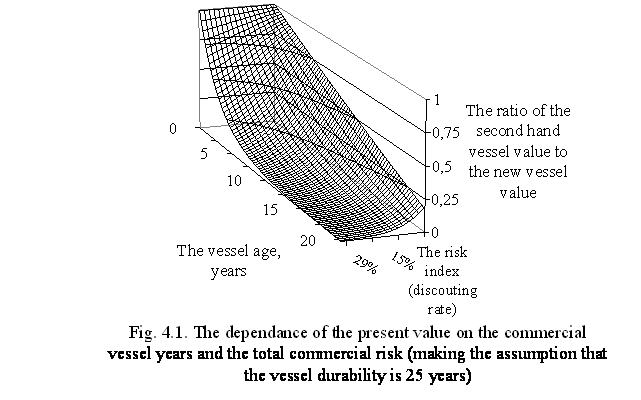
|
(4.4) |
|
(4.5) |
|
(4.6) |
|
(4.7) |
|
(4.8) |
|
(4.9) |
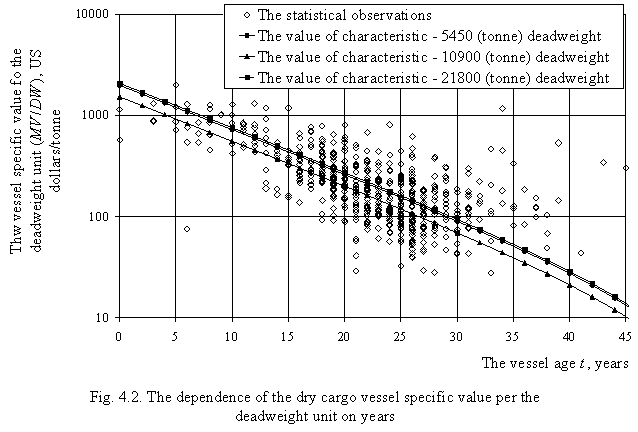
The discounting rate i counted by the market extraction from statistics and marketing researches is released from external risks and retrospective.
According to the discounting rate i the efficiency of investments into construction and productive operation of the universal dry–cargo vessels determined by the market extraction method makes approximately i≈ 8.5 %.
When substituting the specified value of the discounting rate i into the factor ![]() in formulas (4.5, 4.6) the greatest conformity of regression with the data of marketing researches is reached if deadweight of the vessel DW is used as the characteristic.
in formulas (4.5, 4.6) the greatest conformity of regression with the data of marketing researches is reached if deadweight of the vessel DW is used as the characteristic.
Test questions
1. Formal analogy of economic concept of value to physical concept «potential».
2. Potential equation of value.
3. Sign of the present value potential for an asset which value is going down with the increase of years; the asset life time.
4. Depreciation of the isolated real asset over the time, the isolated assets growing in value with the increase of years (examples).
5. Solution of the potential equation for the isolated asset going down in value through the time (formulas derivation).
6. Property complex of real assets value capitalization in the time.
7. Solution of the potential equation of the property complex growing value with the positive potential of value (the discount formula of present value capitalization of own property).
8. Form of a value dependence on the vessel age recommended for approximation of statistical observations when formalizing of the regressions.
9. Recommended parametrical form of dependence of new vessel value on her characteristics.
10. Recommended form of statistical regression dependence of the vessel value on the characteristics and the age, based on use of discounting by the Euler number exponential function (the formula derivation).
11. Determination of the economic life time index and the retrospective discounting rate released from the external risks by the analysis of statistical regression dependence of value on vessel years.
4.5. Marketing research for the commercial vessels value estimation
The market analysis of commercial vessels is based on statistical data processing.
The marketing researches of the vessels values must be conducted using the Internet sites of the broker companies.
According to the data of commercial vessels offered for sale and construction the division of the most widespread classes is presented (fig. 4.3).
The universal dry–cargo vessels are most numerous classes according to offers to sale, despite the fact that tankers have the greatest total tonnage.
The deadweight DW and holds volume W are chosen as units of comparison of the refrigeration vessel.
When using the deadweight DW as the unit of comparison while processing the statistical data of the marketing researches statistical data it is determined that approximation factors are: a1 = 1.585, a2 = 1.255, a3= – 0.0001.
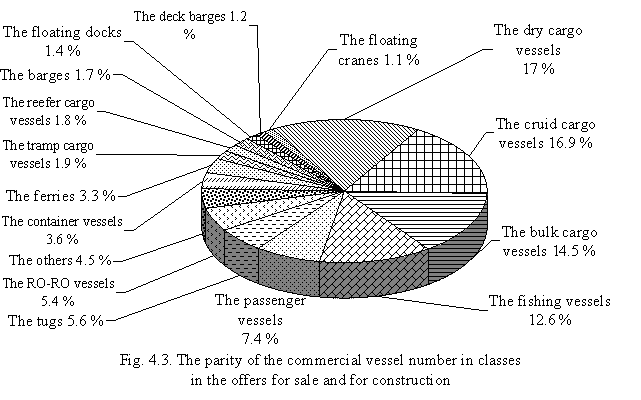
|
(4.10) |
|
(4.11) |
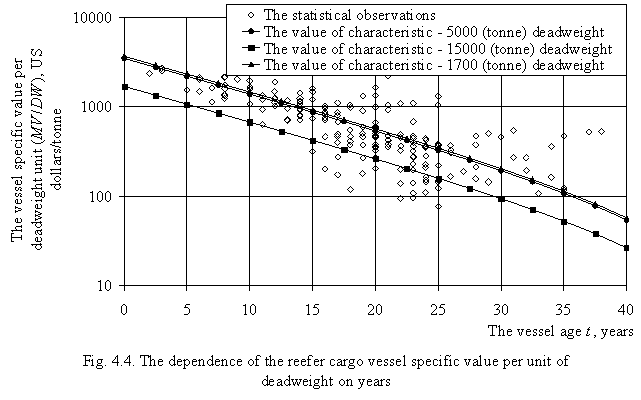
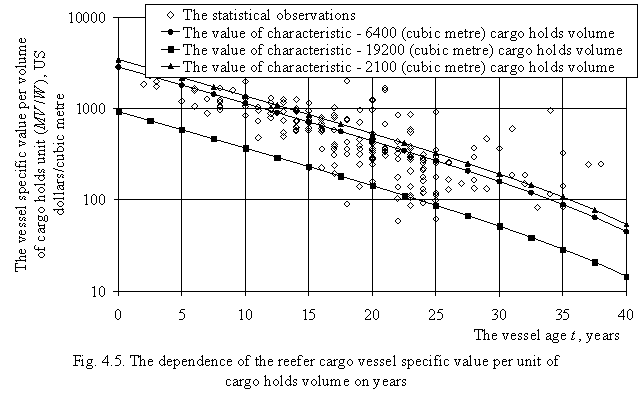
Some useful information: the average value of the refrigeration vessels age offered for sale makes 18.9 years, deadweight – 4990 tonne, hold volume – 6400 cubic meters.
The efficiency of investments into construction and productive operation of the refrigeration vessel makes 9.0 %, that is, the discounting ratefree from external risk is i ≈ 0.09.
When substituting the specified value of the discounting rate i in to the factor ![]() the greatest conformity of approximation results with data of marketing researches is reached.
the greatest conformity of approximation results with data of marketing researches is reached.
The economic life time of cargo refrigeration vessels according to marketing researches makes approximately 50 years.
The specified value of life time is determined by extrapolation of regression dependences to its crossing with the axis of abscises for using in the structure of regression dependences of value on age.
Actually the life time of commercial vessel is a little bit less than the index of economic life time and corresponds to the value reduction below the scrap value.
The average weighed value of refrigeration vessel structural durability makes approximately 45 years.
As a characteristic of comparison of the multi–purpose dry–cargo vessel one should use the index of the commercial vessel length and breadth (L×B), product which characterizes the deck and hold area, that is, capacity of a commercial vessel by the floor space.
When using the indicator of commercial vessel length and breadth (L×B) product as the unit of comparison for processing of the marketing researches statistical data it is determined, that approximation factors are: a1 = 0.125, a2 = 1.90, a3 = – 0.0035.
The regression dependence of the value of the multi–purpose dry–cargo vessel on the age t and unit of comparison, that is, the index of the product of commercial vessel length and breadth (L×B), after derivations looks like:
(4.12) |
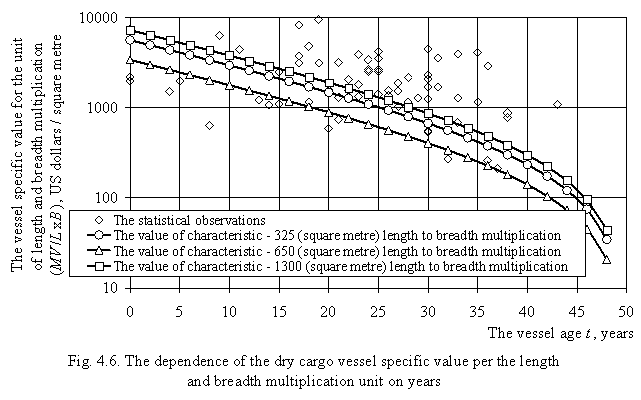
The structural durability of the multi–purpose dry–cargo vessel is a little bit less, than the economic life time specified above and corresponds to the value reduction below the scrap value that makes approximately 45 years.
The regression dependence of the vessel value for transportation bulk cargoes looks like:
|
(4.13) |
|
(4.14) |
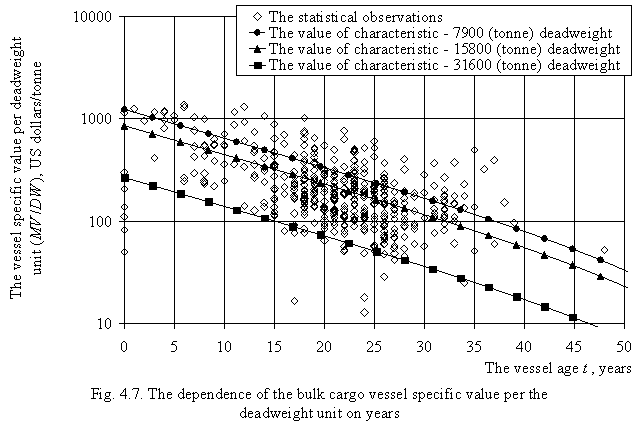
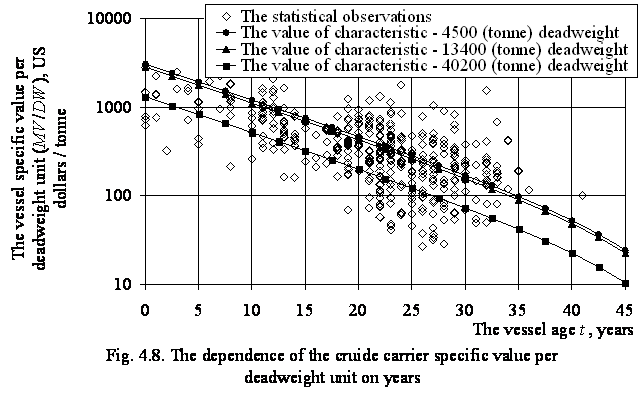
The discounting rate for investments into construction and productive operation of crude–oil tankers free from external risk is i ≈ 9.2 %.
While making marketing researches concerned with offers for construction and sale of rolling cargo vessels it is possible to use deadweight or capacity as the characteristic of comparison.
To preserve uniformity with the results of researches of cargo vessels the deadweight DW is used for cargo vessels of other classes.
It is considered also, that for rolling cargo vessels the relation of capacity to deadweight is basically a property of the cargo, instead of a vessel characteristic, and it makes (according to the studied statistical set) on the average 1.80 cubic meters/tonne, taking into account also the possibility to take the cargo on open deck.
The regression dependence of the rolling cargo vessel value on age t and the unit of comparison (it is the deadweight DW ), considered looks like:
|
(4.15) |
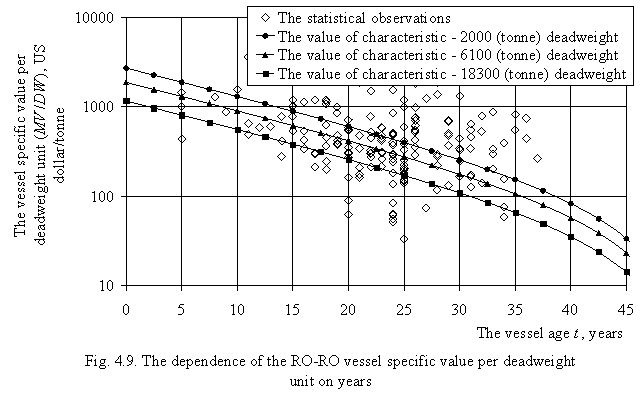
|
(4.16) |
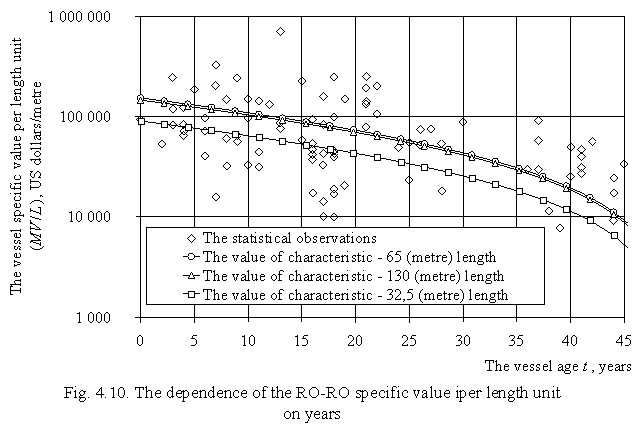
|
(4.17) |
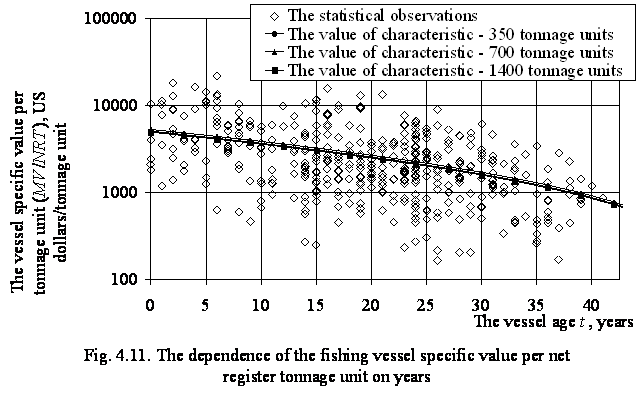
|
(4.18) |
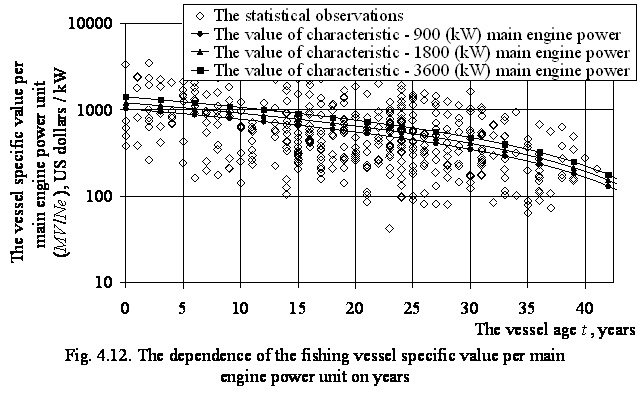
|
(4.19) |
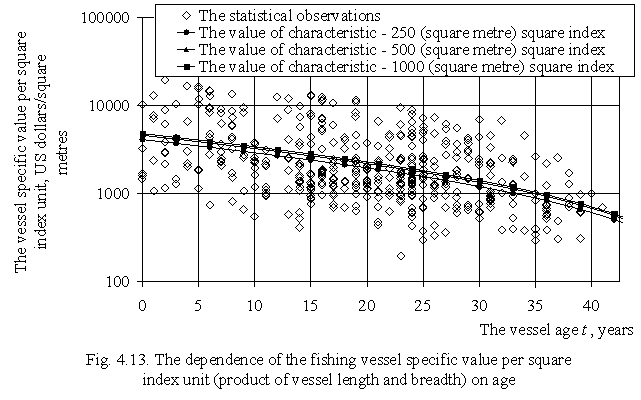
The average weighed value of the marine steel fishing vessel life time determined on the basis of vessels values analysis of marketing data is determined from the set of values: 55.0, 50.0, 53.5 years and it is approximately 53.0 years. The specified values of life time are used in the structure of regression dependences of value on age and received by extrapolation of regression dependences to their crossing with the axis of abscises. According to the marketing researches the average value of the fishing vessels offered for sale, which are more than 50 years old, is less than the scrap value.
The life time determined by extrapolation of regression dependences of the vessel value on age before crossing with the axis of abscises should be estimated only as an element of regression and a datum for value determination by independent approaches since the real life time is also connected with arising risks and actual writing off the operating vessel for scrap is in a greater degree a result of risks estimation. This fact shows that for an operating vessel the dependence of value on age should to be correlated methodologically with the life time estimation according to the statistical regression with the account life time with the age of the vessel approaching its upper limit the error of estimation grows and at the maximum of vessel years the error of estimation becomes proportionate to the value itself.
The methodological value of the regression analysis of statistical observations of vessels’ value marketing data is in the fact that keeping in mind the stated concepts and recommendations the same analysis can be done for other classes of vessel (or in case of macroeconomic changes) when the results must be used for estimation based on comparable sales approach and also for determination of life time and interest rate free from external risks (retrospective) according to the discounting rate that can be applied for estimation by independent approaches.
Test questions
1. Most widespread cargo vessels classes at offered to sale.
2. Cargo vessels class, offered for sale of the greatest tonnage.
3. Determination of the discounting rate free from external risks by the market extraction on the basis of the statistical approach analysis for commercial vessels classes.
4. Determination of commercial vessel life time on the basis of the regression dependence analysis.
5. Theoretical (economic) and structural durability of a commercial vessel.
6. Correlations of vessel years, life time and an error of estimation.
 |
 |
|||||